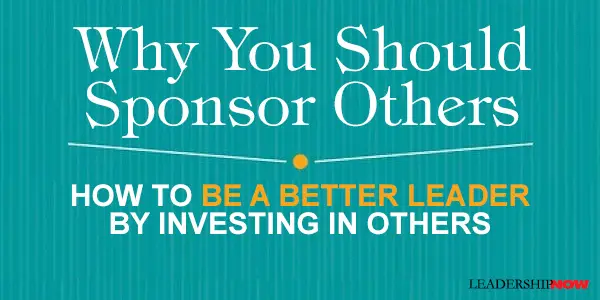 |
 |
02.12.20

Why You Should Sponsor Others
MUCH HAS been written about mentoring. Mentoring is a gift you give to others. And while mentoring can be of tremendous value to the person being guided, it is one-way. Sponsoring is “all-in.” You have skin in the game. Sponsorship is a two-way, reciprocal investment where both the sponsor and the protégé are working for each other’s success. It goes without saying that having a sponsor is a huge career plus, but here’s the startling fact, being a sponsor is just as important as finding one. Sylvia Ann Hewlett reports in her book, The Sponsor Effect, “Senior-level managers are 53 percent more likely to have received a promotion in the last two years, if they have a protégé.” In addition, “Entry-level professionals who have a protégé are 167 percent more likely to have received a stretch assignment than those who don’t.” And for those who were actually doing sponsorship right, the results were even better. The point is, become a sponsor. It’s good for you too! The sponsor must devote serious attention to identifying top junior talent, developing their skills, scrutinizing their progress, and advocating on their behalf (or more practically stated, believing in them and using up precious political capital for them, advocating for them, and providing them with air cover to take the risks that success often demands). Protégés must deliver for their sponsor with stellar performance, rock-solid trustworthiness, and a differentiated skillset that adds value to the team and the organization, as well as to the individual sponsor. Take note: “The right protégé will complement your leadership skills and style, provide honest feedback, make you feel that you have extra hours in the day, and enable your influence to persist even after you’ve moved on to your next role or opportunity.” Seven Steps to Effective Sponsorship Hewlett offers a playbook to do this right. Taking a chapter for each, she explains how to get started, and answers questions like how do you contain risk? And What tools and tactics work best. After all, “If you’re going to sponsor someone—linking their career to yours—they’re going to be walking around with your brand on their forehead.” Step 1: Identify Potential Protégés Step 2: Include Diverse Perspectives Step 3: Inspire for Performance and Loyalty Step 4: Instruct to Fill skills Gaps Step 5: Inspect your Prospects Step 6: Instigate a Deal Step 7: Invest in Three Ways The following example Hewlett shares highlights the value of sponsorship to help leadership groups break out of their shared biases and points of view that so often hold them back. “In this business today, if you want to grow, you’ve got to be comfortable with being uncomfortable,” Lou Aversano, CEO of Ogilvy & Mather in New York (a division of WPP), told me. “You have to be willing to burn your lifeboats before someone burns them for you.” Yet industry veterans such as himself face a challenge that he calls “altitude.” Sponsorship requires an investment of time, but it has immediate value. You can begin to see the benefits very quickly. So, find some protégés today. The Sponsor Effect offers a formula to get it right. 
Posted by Michael McKinney at 08:23 AM
|
BUILD YOUR KNOWLEDGE
 

How to Do Your Start-Up Right STRAIGHT TALK FOR START-UPS 
Grow Your Leadership Skills NEW AND UPCOMING LEADERSHIP BOOKS 
Leadership Minute BITE-SIZE CONCEPTS YOU CAN CHEW ON 
Classic Leadership Books BOOKS TO READ BEFORE YOU LEAD |